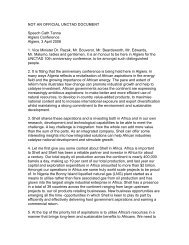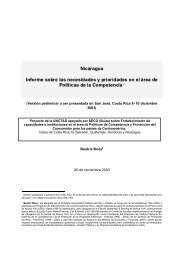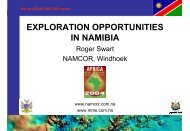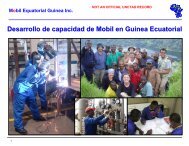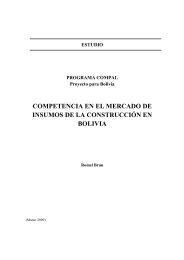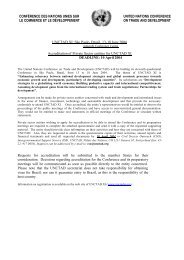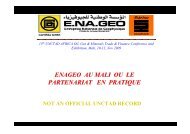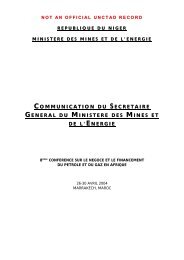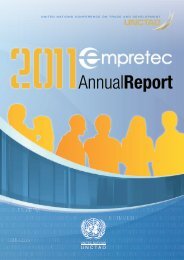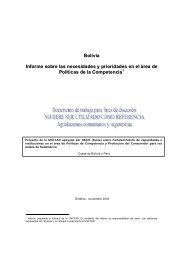Empretec Women in Business Award 2012 publication - Unctad XI
Empretec Women in Business Award 2012 publication - Unctad XI
Empretec Women in Business Award 2012 publication - Unctad XI
- No tags were found...
You also want an ePaper? Increase the reach of your titles
YUMPU automatically turns print PDFs into web optimized ePapers that Google loves.
iEMPRETEC WOMEN IN BUSINESS AWARD <strong>2012</strong>ACKNOWLEDGEMENTSThis <strong>publication</strong> is the result of the work of the <strong>Empretec</strong> team <strong>in</strong> the Entrepreneurship Section of the Enterprise Branch at UNCTAD’s Division onInvestment and Enterprise. It has been prepared under the overall guidance of James Zhan, the supervision of Tatiana Krylova, the leadership andconceptual work of Fior<strong>in</strong>a Mugione and the coord<strong>in</strong>ation of Krist<strong>in</strong> Keveloh.This <strong>publication</strong> would not have been possible without the work, efforts and dedication of a number of contributors. Constructive commentary hascome from Dorothy Dillard and Fulvia Far<strong>in</strong>elli.The <strong>publication</strong> benefited from the editorial comments given by Alan Sternberg and the layout and desktop publish<strong>in</strong>g by Karima Aoukili.Special thanks go to Dr. Margarita Cedeño de Fernández, First Lady of the Dom<strong>in</strong>ican Republic, Anthony Gribben from the European Tra<strong>in</strong><strong>in</strong>gFoundation, author Gayle Tzemach Lemmon, Peer Ste<strong>in</strong> and Marieme Esther Dassanou from IFC who contributed to this <strong>publication</strong> by shar<strong>in</strong>gtheir experience and thoughts on women entrepreneurship <strong>in</strong> the chapter “Thoughts from Experts”.Thanks also go to the <strong>Empretec</strong> Directors who provided us with the amaz<strong>in</strong>g stories of their nom<strong>in</strong>ees and to the10 f<strong>in</strong>alists of the WBA whoshared their excit<strong>in</strong>g stories with us.
CONTENTSiiCONTENTSACKNOWLEDGEMENTSCONTENTSPREFACEABOUT EMPRETEC AND THE WOMEN IN BUSINESS AWARD10 FINALISTS <strong>2012</strong>AWARD PANEL <strong>2012</strong>IMPACTTHOUGHTS FROM EXPERTSINITIATIVESIIIIIIV123273341
iiiEMPRETEC WOMEN IN BUSINESS AWARD <strong>2012</strong>PREFACEThe case for gender equality is unequivocal. It is a fundamental condition for the full enjoyment of human rights and a crucial factor <strong>in</strong>reduc<strong>in</strong>g poverty and spurr<strong>in</strong>g economic growth. Its importance is highlighted <strong>in</strong> Millennium Development Goal 3 on promot<strong>in</strong>g gender equalityand empower<strong>in</strong>g women.Discrim<strong>in</strong>ation aga<strong>in</strong>st and marg<strong>in</strong>alization of women make societies worse off. Just as with <strong>in</strong>come <strong>in</strong>equality, gender discrim<strong>in</strong>ation tends toreduce growth and to hold back development by crippl<strong>in</strong>g a significant part of society’s human capital – <strong>in</strong> this case 50 per cent. By contrast,there is ample evidence that enhanced opportunities for women lead to improvements <strong>in</strong> poverty reduction and to accelerated economic growth.It is therefore high time for gender equality to be <strong>in</strong>corporated more broadly <strong>in</strong>to development efforts, <strong>in</strong>clud<strong>in</strong>g measures related to trade,<strong>in</strong>vestment and entrepreneurship.The United Nations Conference on Trade and Development (UNCTAD) has both the responsibility and the expertise to play a key role <strong>in</strong> ensur<strong>in</strong>gthat gender concerns are <strong>in</strong>corporated <strong>in</strong> a mean<strong>in</strong>gful way <strong>in</strong> economic policies, <strong>in</strong>clud<strong>in</strong>g trade, <strong>in</strong>vestment and enterprise development. As partof its mandate, UNCTAD has been work<strong>in</strong>g on gender and development-related issues s<strong>in</strong>ce the 1990s. UNCTAD activities <strong>in</strong>clude research,<strong>in</strong>tergovernmental discussions, capacity-build<strong>in</strong>g for policymakers, tra<strong>in</strong><strong>in</strong>g of entrepreneurs, and the shar<strong>in</strong>g of lessons, best practices andexamples. UNCTAD is currently analys<strong>in</strong>g how <strong>in</strong>novation affects women entrepreneurs and how science and technology can be made moreresponsive to the needs of women.The Accra Accord result<strong>in</strong>g from UNCTAD’s twelfth M<strong>in</strong>isterial Conference – held <strong>in</strong> Accra, Ghana, <strong>in</strong> April 2008 – requested theorganization to strengthen its work on the l<strong>in</strong>kages between trade and <strong>in</strong>ternationally agreed development goals and objectives,<strong>in</strong>clud<strong>in</strong>g those related to gender, and to make efforts to ma<strong>in</strong>stream cross-cutt<strong>in</strong>g issues of gender equality and the empowermentof women <strong>in</strong> all its work. UNCTAD is currently <strong>in</strong> the process of implement<strong>in</strong>g a strategy of “gender ma<strong>in</strong>stream<strong>in</strong>g” <strong>in</strong> the substantivework of the organization. Its purpose is to better enable UNCTAD staff and the whole organization to address gender-related issuesand to look at the topics <strong>in</strong>cluded <strong>in</strong> UNCTAD’s mandate through a “gender lens”.UNCTAD has carried out a research project on women entrepreneurship and <strong>in</strong>novation, supported by the Swedish Government. Theproject exam<strong>in</strong>ed the process of <strong>in</strong>novation from a gender perspective <strong>in</strong> both developed and develop<strong>in</strong>g economies. It exam<strong>in</strong>edwhat impediments to <strong>in</strong>novation there may be from a structural or societal perspective and how these impediments may vary bygender. The report suggested policy recommendations and best practices to foster a greater level of <strong>in</strong>novation <strong>in</strong> women-ownedenterprises.UNCTAD, <strong>in</strong> its role as Lead Agency of the United Nations Inter-agency Task Force on Gender and Trade, has produced a resourcepaper on gender equality and trade policy which reflects the views of the United Nations system on the issue. The paper is <strong>in</strong>tendedto enhance policymakers abilities to ensure that men and women equally benefit from trade.
vEMPRETEC WOMEN IN BUSINESS AWARD <strong>2012</strong>ABOUT EMPRETEC AND THE WOMEN IN BUSINESS AWARDWhile the number of women entrepreneurs is grow<strong>in</strong>g across the globe, women still have lower participation rates <strong>in</strong> entrepreneurship than menand are generally engaged <strong>in</strong> different areas of entrepreneurship from men (although this pattern is not universal – see the accompany<strong>in</strong>g article“Go<strong>in</strong>g Beyond Micro”). Studies have shown that women-owned enterprises are, to a much higher proportion, located <strong>in</strong> the <strong>in</strong>formal sector thanare firms owned by men. The firms also tend to be smaller. Additionally, women often carry an extra burden: they must divide their time betweenbus<strong>in</strong>ess and family. The result is that women generally rema<strong>in</strong> low wage earners with low levels of marketable skills. They are usually among thefirst to be laid off dur<strong>in</strong>g economic downturns.Clearly, it is both economically and socially important to remedy this situation. Steps are needed to support and promote entrepreneurship amongwomen. <strong>Women</strong> should be offered tra<strong>in</strong><strong>in</strong>g, assistance and mentor<strong>in</strong>g <strong>in</strong> how to establish and expand a bus<strong>in</strong>ess. And these services should betailored to women’s needs. UNCTAD’s <strong>Empretec</strong> programme and the <strong>Empretec</strong> <strong>Women</strong> <strong>in</strong> Bus<strong>in</strong>ess <strong>Award</strong>s are <strong>in</strong>tended to serve this purpose.<strong>Empretec</strong><strong>Empretec</strong> helps promis<strong>in</strong>g entrepreneurs build <strong>in</strong>novative and <strong>in</strong>ternationally competitive micro-, small-, and medium-sized enterprises.<strong>Empretec</strong>’s core product, the Entrepreneurship Tra<strong>in</strong><strong>in</strong>g Workshop, teaches entrepreneurs how to put their ideas <strong>in</strong>to practice. Participants aretaught to identify bus<strong>in</strong>ess opportunities and to take practical steps to expand fledg<strong>in</strong>g bus<strong>in</strong>esses. The programme, which is delivered <strong>in</strong> 6- to10-day sessions, focuses on motivation and strengthen<strong>in</strong>g entrepreneurial talentsS<strong>in</strong>ce its <strong>in</strong>ception <strong>in</strong> 1988, the <strong>Empretec</strong> network has expanded to 32 countries. In cooperation with national counterparts, the programme hasassisted more than 240,000 entrepreneurs through local <strong>Empretec</strong> centres by 2011. These entrepreneurs have founded and/or expandedbus<strong>in</strong>esses that have created hundreds of thousands of jobs.
10 FINALISTS <strong>2012</strong>
3Barbara Zoe NyikaBarbara Nyika Mbira Academy (BANMA) – ZIMBABWEEMPRETEC WOMEN IN BUSINESS AWARD <strong>2012</strong>“Our mission is to contribute to the preservation of Zimbabwe’s cultural heritage, both tangibleand <strong>in</strong>tangible, through support<strong>in</strong>g the orig<strong>in</strong>al and authentic manufactur<strong>in</strong>g of mbira <strong>in</strong>strumentsand through teach<strong>in</strong>g new generations how to play the <strong>in</strong>strument.“
10 FINALISTS <strong>2012</strong> 4The mbira, the traditional <strong>in</strong>strument of the Shona culture, plays a majorrole <strong>in</strong> Zimbabwe’s musical and cultural life. It comes <strong>in</strong> several sizes andconsists of staggered metal keys or prongs attached to one end of awooden board which resonates and amplifies the sound. The free endsof the metal prongs are plucked and produce a chim<strong>in</strong>g tone. Mbira musichas a cyclical, improvised, hypnotic quality based on repetition with slightmelodic variations. The <strong>in</strong>struments are often played <strong>in</strong> ensembles andare accompanied by the hosha (rattle) and drums, with lead and secondaryvocal parts. The mbira is the only musical <strong>in</strong>strument recognized bythe United Nations Educational, Scientific and Cultural Organization(UNESCO) as a basis of cultural heritage. Founded <strong>in</strong> 2008, BANMA manufactures and sells mbiras, teachesstudents how to play the <strong>in</strong>strument, performs as a band at frequent corporate events at Harare, Zimbabwe’s,largest hotel, where the firm has an office, performs and sells <strong>in</strong>struments at festivals and other large events– such as the 2010 World Cup <strong>in</strong> South Africa – and markets mbiras to tourists.The bus<strong>in</strong>ess began with an <strong>in</strong>vestment of $3,000, but by the time Barbara attended an <strong>Empretec</strong> workshop<strong>in</strong> February, 2009, “I was almost w<strong>in</strong>d<strong>in</strong>g up the bus<strong>in</strong>ess. The tra<strong>in</strong>ers taught us about bus<strong>in</strong>ess plans andwe discovered that all we had done was done haphazardly... The <strong>Empretec</strong> tra<strong>in</strong><strong>in</strong>g was provided <strong>in</strong> a fewdays, but bang.” Revenue <strong>in</strong>creased to $40,000 by the end of 2009 and to $70,000 <strong>in</strong> 2010, and thefirm expanded from two employees <strong>in</strong> 2008 to12 full-time and eight contract employees <strong>in</strong> 2011. Locationof BANMA’s office was shifted from Barbara’s home, which was hard to reach and “where customers nevertook me seriously,” to the Ra<strong>in</strong>bow Towers Hotel. To f<strong>in</strong>ance the move, Barbara sold her car. Now the firmhas two ma<strong>in</strong> offices and several satellite offices.A short-term goal is to purchase modern mach<strong>in</strong>ery so that mbiras can be manufactured more quickly.Barbara is also pursu<strong>in</strong>g a longer-term project of establish<strong>in</strong>g the study of mbira music <strong>in</strong> Zimbabwe’s publicschools. She hopes eventually to open a formal mbira music academy <strong>in</strong> Harare. There is no similar culturallyfocused firm headed by a woman <strong>in</strong> Zimbabwe.Barbara Nyika MbiraAcademy (BANMA)14 Dunmore Ave,QueensdaleHarare, Zimbabwe
7Funmi Victor-OkigboNo Surprises Ltd. – NIGERIAEMPRETEC WOMEN IN BUSINESS AWARD <strong>2012</strong>“We are a quirky and dynamic experiential market<strong>in</strong>g agency, specializ<strong>in</strong>g <strong>in</strong> the design andproduction of events. We have a name for our unique approach to creat<strong>in</strong>g and manag<strong>in</strong>g corporateand show-bus<strong>in</strong>ess events: We call it Event Architecture.“
10 FINALISTS <strong>2012</strong>8No Surprises designs and stages events for corporations, the Nigerianenterta<strong>in</strong>ment <strong>in</strong>dustry and non-profit organizations. The grow<strong>in</strong>g <strong>in</strong>flux ofmult<strong>in</strong>ational companies <strong>in</strong>to Nigeria has expanded the market for eventmanagement, and No Surprises has established a reputation for colourfuland even outlandish ideas and presentations featur<strong>in</strong>g light shows, music,food, art and eye-catch<strong>in</strong>g <strong>in</strong>vitations.“I wanted a complete departure from the conservative approach to a moreradically trendy approach”, Funmi expla<strong>in</strong>s. For a Gu<strong>in</strong>ness Conference and250th anniversary, No Surprises began with an <strong>in</strong>formal pool-side barbecue,then offered a performance by the Malta Gu<strong>in</strong>ness Street DanceTeam, and then enlisted all those attend<strong>in</strong>g <strong>in</strong> a “total group drumm<strong>in</strong>g activity”. A conference for GoogleNigeria featured a photo booth with playful props where attendees posed for pictures while wait<strong>in</strong>g to register.The venue <strong>in</strong>cluded a “chill-out zone” with colourful bean-bag chairs and cubes where attendees could loungedur<strong>in</strong>g breaks, and conference ushers were identifiable by their colourful “geek” glasses.The firm provides services <strong>in</strong>clud<strong>in</strong>g (a) the plann<strong>in</strong>g of events; (b) the selection and contract<strong>in</strong>g of venues; (c)the book<strong>in</strong>g of musicians and other performers; (d) the arrangement of cater<strong>in</strong>g and selection of menus; (e)post-event cleanup; (f) furniture rental; (g) security staff<strong>in</strong>g; (h) transportation arrangements; (i) <strong>in</strong>surance andlicens<strong>in</strong>g; (j) floral and landscape decoration; and (k) set and stage design. “We have a team of experts with arefresh<strong>in</strong>g approach to event management. We set out to change the way people th<strong>in</strong>k and feel about brandsthrough creat<strong>in</strong>g unique experiences.” After six years <strong>in</strong> bus<strong>in</strong>ess, No Surprises has grown from 2 to 10 permanentemployees, and it hires as many as 50 temporary workers depend<strong>in</strong>g on the size of the events it undertakes.Some 60 per cent of employees are women – “I really source for competence over and above gender, althoughI th<strong>in</strong>k women are more <strong>in</strong>tuitively wired. They dream and create.” The firm’s sales grew 44 per cent <strong>in</strong> 2009and by more than 100 per cent <strong>in</strong> 2010. Through attend<strong>in</strong>g an <strong>Empretec</strong> tra<strong>in</strong><strong>in</strong>g workshop <strong>in</strong> 2009, Funmilearned how better “to structure entrepreneurial competencies and most especially opportunity-seek<strong>in</strong>g”. Shesaw a grow<strong>in</strong>g demand for professional services for wedd<strong>in</strong>gs <strong>in</strong> Nigeria and founded a second firm called “TheWedd<strong>in</strong>g Company”. She also says the workshop helped her to become “much better at network<strong>in</strong>g with otherentrepreneurs”.No Surprises Ltd.No 3B Ahmad TijjaniOttun Street LekkiPhase 1,Lagos, Nigeriawww.nosurprisesevents.comAmong Funmi’s goals are to <strong>in</strong>crease the firm’s share <strong>in</strong> the Lagos corporate and show-bus<strong>in</strong>ess market by 25per cent, and to manage an <strong>in</strong>creas<strong>in</strong>g number of events outside Nigeria.
10 FINALISTS <strong>2012</strong>10AURORA separates, collects, prepares and sells to recycl<strong>in</strong>g firms – several ofthem overseas – solid <strong>in</strong>organic waste from 20 Salvadoran companies and<strong>in</strong>stitutions. This material “would otherwise be garbage”, Maria Carlota reports, and<strong>in</strong> fact “the idea to start AURORA came from realiz<strong>in</strong>g the enormous amount ofgarbage piled up <strong>in</strong> the streets of El Salvador. When it ra<strong>in</strong>ed, the sewers wouldbe blocked with this waste. The street sewers were contam<strong>in</strong>ated; the birds builttheir nests us<strong>in</strong>g plastic or glass fibre; plastic bags hung from the trees. We knowthat this waste, if prepared adequately, has market value. The comb<strong>in</strong>ed action ofde-contam<strong>in</strong>at<strong>in</strong>g critical areas and recycl<strong>in</strong>g their components seemed to havethe potential for a bus<strong>in</strong>ess, not only a profitable one but also a valuable one for the country.” The firm began with capitalof $15. “This capital did not even allow us to have an office.” But then AURORA received a two-year bus<strong>in</strong>ess <strong>in</strong>cubatorgrant from FUNDEMAS (Fundacion Empresarial para la Accion Social, the host of the <strong>Empretec</strong> Centre) and began to f<strong>in</strong>dclients. It obta<strong>in</strong>ed a permit from the M<strong>in</strong>istry of the Environment allow<strong>in</strong>g it to dispose of waste – and also authoriz<strong>in</strong>g it togive tra<strong>in</strong><strong>in</strong>g sessions on environmental responsibility to Salvadoran companies. It now provides clients and suppliers withformally written statements backed by the M<strong>in</strong>istry for the Environment stat<strong>in</strong>g the amount that each <strong>in</strong>stitution recycles ona monthly basis and certify<strong>in</strong>g its clients as “green” enterprises.It collects and disposes of different types of plastic, paper, carton, electronic equipment, computer equipment, corrosiveand non-corrosive materials, batteries and oil. It was strongly affected by the 2009 recession but expected to be profitableby the end of 2011 and to attract additional <strong>in</strong>vestment capital. It began with 2 permanent employees and as of 2011had 6 permanent and 10 seasonal or temporary workers. Among the challenges faced by the firm has been a 2008Salvadoran law prohibit<strong>in</strong>g the export of corrosive metals and sett<strong>in</strong>g up a monopoly arrangement that excluded AURORAfrom a potentially lucrative export market. “We quickly had to adapt and dedicate ourselves to export<strong>in</strong>g other types ofwaste and search for other markets <strong>in</strong> Central America. We now have negotiated with Guatemala and Honduras which willallow us to send several conta<strong>in</strong>ers of material to the Asian cont<strong>in</strong>ent.”AURORA now has 13 buyers for the waste it collects – 10 domestic, and 3 <strong>in</strong>ternational. Growth prospects appearstrong: “The tendencies of the sector are towards demand and better prices <strong>in</strong>ternationally, high prices for virg<strong>in</strong> <strong>in</strong>puts,fiscal benefits, and demand that is bigger than supply.” Maria Carlota attended a March 2010 <strong>Empretec</strong> workshop ondevelop<strong>in</strong>g entrepreneurial capacity and says, “My entrepreneurial life has two phases: before <strong>Empretec</strong> and after. Before, Iwasted numerous opportunities I had <strong>in</strong> front of me and didn’t recognize.” She says that through work<strong>in</strong>g more effectivelywith support networks and through tak<strong>in</strong>g advantage of strategic networks, “In the eyes of our clients and buyers, we havebecome a trustworthy source of waste disposal, with personalized service, professional attention, compliance with ourdelivery dates, regular pickups, qualified personnel, and guaranteed adequate clear<strong>in</strong>g and transport.” Goals for the firm<strong>in</strong>clude expand<strong>in</strong>g to 23 permanent employees, obta<strong>in</strong><strong>in</strong>g its own fleet of trucks, and extend<strong>in</strong>g waste collection to <strong>in</strong>cludehomes as well as Salvadoran bus<strong>in</strong>esses. AURORA also hopes to open a reprocess<strong>in</strong>g plant for used tires and eventuallyto operate throughout Central America.AURORAColoniaEscalon Norte, CalleBeethoven No. 53San Salvador,El Salvadorwww.fundacionaurora.blogspot.com
11EMPRETEC WOMEN IN BUSINESS AWARD <strong>2012</strong>Jane Frances NakatoK<strong>in</strong>derKare Pre-School – UGANDA“Our mission is to provide high-quality child care and education <strong>in</strong> a safe, clean, and secureenvironment.“
10 FINALISTS <strong>2012</strong>12K<strong>in</strong>derKare Pre-School has succeeded by turn<strong>in</strong>g day care <strong>in</strong>to an effectiveand pleasant form of education for children aged 1 and a half to 6. Itnow operates schools <strong>in</strong> three suburbs of Kampala – Kansanga, Bukotoand Bugolobi – that are convenient for the capital city’s grow<strong>in</strong>g surround<strong>in</strong>gpopulation of middle- and high-<strong>in</strong>come families. Jane describes theschools’ approach as “semi-<strong>in</strong>ternational”, mean<strong>in</strong>g that children are laterable to move on successfully to <strong>in</strong>ternational schools <strong>in</strong> Uganda andelsewhere. Classes are small, classrooms are colourful and kept very clean,teachers are unusually well-tra<strong>in</strong>ed, and great emphasis is placed on booksand read<strong>in</strong>g. Each child keeps a diary, for example. Other effective teach<strong>in</strong>gaids, <strong>in</strong>clud<strong>in</strong>g computer learn<strong>in</strong>g, also are employed. Frequent meet<strong>in</strong>gs are held between teachers and parents,and children are encouraged to cont<strong>in</strong>ue their learn<strong>in</strong>g activities at home <strong>in</strong> cooperation with their parents.The first pre-school opened <strong>in</strong> 2004, but a great deal of growth and success followed Jane’s attendance ata series of <strong>Empretec</strong> workshops beg<strong>in</strong>n<strong>in</strong>g <strong>in</strong> 2008. She took the basic entrepreneurship course and thenattended bus<strong>in</strong>ess-development courses on brand<strong>in</strong>g, cost<strong>in</strong>g and pric<strong>in</strong>g, market access, effective customercare, f<strong>in</strong>ancial management and “keep<strong>in</strong>g momentum”. Among the benefits she derived were greatly improvedbudget<strong>in</strong>g and plann<strong>in</strong>g, better communication and relations with parents and better tra<strong>in</strong><strong>in</strong>g and cultivation ofstaff, thus solv<strong>in</strong>g a serious problem of frequent staff turnover. “After the tra<strong>in</strong><strong>in</strong>g, we started handl<strong>in</strong>g our staffmuch better and realized a big change <strong>in</strong> the way they work now. The turnover is much, much less.” K<strong>in</strong>derKarebegan with 5 employees and now has 57 permanent staff and 10 temporary workers. Over 80 per cent ofthe staff is women, and five women are <strong>in</strong> management roles. Enrollment grew from 219 children at the endof 2009 to 292 <strong>in</strong> 2011. Revenue <strong>in</strong>creased by 61 per cent between 2009 and 2011. “We tra<strong>in</strong> women,mostly high school and college leavers to become the best k<strong>in</strong>dergarten teachers,” Jane says. “Those tra<strong>in</strong>edby us have repeatedly turned out to perform much better than those who went through formal nursery schooltra<strong>in</strong><strong>in</strong>g. Because of our reputation for staff tra<strong>in</strong><strong>in</strong>g and development, more nursery schools reach out to usto tra<strong>in</strong> and develop their staff members.” The school also holds parent<strong>in</strong>g sessions and curriculum tra<strong>in</strong><strong>in</strong>g forparents. K<strong>in</strong>derKare has been written about <strong>in</strong> the country’s lead<strong>in</strong>g newspaper, The New Vision, and has beenfeatured on the lead<strong>in</strong>g Ugandan television network, Nation Television (NTV).K<strong>in</strong>derKarePre-SchoolPlot 448 Bukoto CrescentP.O. Box 11798Kampala, Ugandawww.k<strong>in</strong>derkarepreschool.comJane says a fourth pre-school should be opened with<strong>in</strong> two years. Longer-term goals <strong>in</strong>clude expand<strong>in</strong>genrollment to 1,000 and establish<strong>in</strong>g partnerships with early childhood schools <strong>in</strong> other East African countries.
10 FINALISTS <strong>2012</strong>14María José runs four bus<strong>in</strong>esses <strong>in</strong> a small Ecuadorian community whichare focused as much on the social needs of her neighbours as they areon turn<strong>in</strong>g a profit. M&S Compu Solution, founded <strong>in</strong> 2003, offers Internetaccess and a wide range of <strong>in</strong>formation technology services, <strong>in</strong>clud<strong>in</strong>gthe sale and ma<strong>in</strong>tenance of computers. It dist<strong>in</strong>guishes itself from severalcompetitors by stay<strong>in</strong>g open on Saturdays and Sundays from 9 a.m. to 9p.m., by “treat<strong>in</strong>g customers like family members” and by offer<strong>in</strong>g servicesvaluable to the community. The firm’s sales doubled between 2008 and2010.Aso mujeres Lumbisí is an organic farm where vegetables and fruits are grown without chemicals or fertilizers<strong>in</strong> partnership with 26 local women, most of whom are over age 60 and some of whom are disabled. Thework gives them a constructive role <strong>in</strong> the community, helps to re-establish their self-esteem, offers the senseof work<strong>in</strong>g <strong>in</strong> harmony with the environment, and provides <strong>in</strong>come – deposited each month <strong>in</strong> a sav<strong>in</strong>gs bank– that serves them as f<strong>in</strong>ancial security <strong>in</strong> case of illness or other problems. “We improve their own and theirfamilies’ food security.” The prices for the produce sold by the farm “are fair and we do not use <strong>in</strong>termediaries.”Ball Three is an enterprise based on two soccer fields – which are rented for use – and on the sales of snacksand on the organization of soccer tournaments. Because of a shortage of public recreation space and limits onmembership to local sports clubs, the firm is valuable for provid<strong>in</strong>g sports, social cohesion, and family activitiesto the community. “I create a space to enterta<strong>in</strong> people <strong>in</strong> a healthy way by do<strong>in</strong>g sports or develop<strong>in</strong>g otherskills.” Ball Three’s sales figures tripled with<strong>in</strong> one year.María José also operates Criader Artesanal de Cerdos, a pig farm where “the animals are very well bred and fedorganically. We prepare mar<strong>in</strong>ades, side dishes, and bake pork us<strong>in</strong>g a wood oven.”Overall, María José’s revenues have <strong>in</strong>creased by 35 per cent over the past three years. She credits <strong>Empretec</strong>for teach<strong>in</strong>g her “to accept my mistakes, to plan, and to organize myself and other people. It helped me to get aview of what was really important to me, and my character improved.” Among María José’s goals are to expandthe production of the organic garden, build a warehouse to store organic produce, rebuild the cybercafé, andexpand the pig farm from two breed<strong>in</strong>g sows to five to ensure cont<strong>in</strong>uous production of meat.M&S Compu SolutionAso mujeres LumbisiBall ThreeTelmo Hidalgo Lumbisi,Cumbayá, Ecuador
15EMPRETEC WOMEN IN BUSINESS AWARD <strong>2012</strong>Melissa De LeonTropical Panama Gourmet – PANAMA“What I am good at is work<strong>in</strong>g shoulder to shoulder with my staff, always giv<strong>in</strong>g the best of me andallow<strong>in</strong>g them to always see me <strong>in</strong>volved <strong>in</strong> the production process.“
10 FINALISTS <strong>2012</strong>16Tropical Panama Gourmet produces and markets food products based onflour made from locally grown tubers that do not conta<strong>in</strong> gluten – a prote<strong>in</strong>found <strong>in</strong> wheat, barley and oats. Gluten-free flour provides healthy nutritionfor diabetics, persons with celiac disease, persons allergic to wheat, andelderly persons with digestive problems. It also is a valuable base for babyfood and is often recommended for persons suffer<strong>in</strong>g from autism andcancer. Melissa devised a flour mak<strong>in</strong>g use of the entire tuber of locallygrown crops, thus enabl<strong>in</strong>g her supply<strong>in</strong>g farmers to sell their crops withoutwaste and to earn steady <strong>in</strong>comes. And her goods have a shelf life of 10months without the use of additives or preservatives, which makesshipment of the product overseas commercially competitive.The market for gluten-free f<strong>in</strong>ished products <strong>in</strong> the United States and Canada alone is some $1.6 billion peryear and is expected to grow by 28 per cent over the next four years. Tropical Panama Gourmet is the onlyproducer of gluten-free food <strong>in</strong> Lat<strong>in</strong> America. The <strong>in</strong>tent of the firm is not only to expand sales but to supportPanamanian agribus<strong>in</strong>ess, “which is underutilized”, and to help establish a national reputation for <strong>in</strong>novative andhealthy products. In addition, the company provides tra<strong>in</strong><strong>in</strong>g services, cook<strong>in</strong>g courses, and personalized cater<strong>in</strong>g.Melissa began with a staff of one – herself – and without a commercial kitchen. Earn<strong>in</strong>gs were $100–$300per month. Now the firm has 10 employees, 8 of whom are women.“My ambition is to export 100 per cent Panamanian products, while at the same time contribut<strong>in</strong>g to agribus<strong>in</strong>ess<strong>in</strong> my country and promot<strong>in</strong>g healthy nutrition.” The company has been selected as one of 4 f<strong>in</strong>alists fromamong 250 entrants <strong>in</strong> a bus<strong>in</strong>ess <strong>in</strong>cubator competition. She credits <strong>Empretec</strong> tra<strong>in</strong><strong>in</strong>g with “allow<strong>in</strong>g me toobta<strong>in</strong> <strong>in</strong>tense and hands-on feedback on how to improve my bus<strong>in</strong>ess project, and how to get the best out ofmy ability. After the workshop, I developed a bus<strong>in</strong>ess plan to present to prospective <strong>in</strong>vestors.” Goals for TropicalPanama Gourmet <strong>in</strong>clude “lead<strong>in</strong>g the United States and European market” <strong>in</strong> sales of gluten-free f<strong>in</strong>ishedfoods, tripl<strong>in</strong>g the firm’s workforce, and expand<strong>in</strong>g production by a factor of 100.Tropical PanamaGourmetCity of Knowledge,Clayton, Panamá City,Republic of Panamáwww.panamagourmet.net
17EMPRETEC WOMEN IN BUSINESS AWARD <strong>2012</strong>Patricia Paz Silva GiordaniMoura e Paz – Soluções Ambientais – BRAZIL“My bus<strong>in</strong>ess idea at Moura e Paz is totally devoted to environmental preservation _ to protect<strong>in</strong>gthe future of this planet and of the next generation.“
10 FINALISTS <strong>2012</strong>18“When I f<strong>in</strong>ished <strong>Empretec</strong>, I had a firm will to start a new bus<strong>in</strong>ess thatwould be <strong>in</strong>novative and enterpris<strong>in</strong>g – a job that I could manage as ahealth professional who had practiced for years as a dentist. It justhappened that I was f<strong>in</strong>ed for caus<strong>in</strong>g damage to the environment <strong>in</strong> acl<strong>in</strong>ic I had opened. With <strong>Empretec</strong>, I had learned that a crisis can betransformed <strong>in</strong>to an opportunity, and that is what happened. I founded anew firm to offer environmental solutions for solid waste.” Based <strong>in</strong> one ofthe poorest Brazilian States, Moura e Paz carries out the environmentallysafe collection, transport and f<strong>in</strong>al treatment of dangerous goods such as<strong>in</strong>dustrial and medical waste.The firm owns an <strong>in</strong>c<strong>in</strong>erator and a gas cleaner. It provides emissions-monitor<strong>in</strong>g services with temperature sensorsonl<strong>in</strong>e that give read<strong>in</strong>gs every 10 seconds. Its environmental services conform with Brazilian legislation. “Ourma<strong>in</strong> objective is to preserve the environment, and therefore we also treat water that we use <strong>in</strong> our firm andtreat the gas before it is released <strong>in</strong>to the atmosphere.” Because of the high technology required, there are fewfirms <strong>in</strong> Brazil that can offer such services. Every customer receives a report of the <strong>in</strong>c<strong>in</strong>eration of wastecollected from his bus<strong>in</strong>ess; customers also receive certification of f<strong>in</strong>al treatment of the waste <strong>in</strong> accordancewith regulations. These documents can be used to certify companies’ compliance with the law. “Our customersare obliged by the law to treat all waste generated by their activities. Unfortunately, for many years, firms andmedical centres, such as dental offices, disposed their waste <strong>in</strong> the open air, <strong>in</strong>clud<strong>in</strong>g such dangerous wasteas needles, dirty gas and blood. S<strong>in</strong>ce start<strong>in</strong>g up <strong>in</strong> 2008 we’ve had growth of 260 per cent and hope toclose the fiscal year 2011 with growth of 300 per cent.” The staff at Moura e Paz has expanded from 2 to 22.Employees receive regular tra<strong>in</strong><strong>in</strong>g to upgrade their professional skills. The firm also organizes tra<strong>in</strong><strong>in</strong>g forcustomers and for the municipalities where clients are based. Challenges <strong>in</strong> establish<strong>in</strong>g the firm were many,<strong>in</strong>clud<strong>in</strong>g “ga<strong>in</strong><strong>in</strong>g customers because there was a lot of resistance to the acceptance of environmentalprotection, especially its costs”. There also was a lengthy process of obta<strong>in</strong><strong>in</strong>g permits and licens<strong>in</strong>g related toenvironmental work and waste disposal. “But we are now established <strong>in</strong> the market, and our profits are grow<strong>in</strong>gslowly but surely.”Moura e Paz –Soluções AmbientaisSetor 12, Lote 58R/2E,Gleba CorumbiaraBrazilwww.mouraepaz.com.br
19EMPRETEC WOMEN IN BUSINESS AWARD <strong>2012</strong>Raghda KurdiAdvanced Pharmaceutical Services – JORDAN“My bus<strong>in</strong>ess is unique because no one else provides retail pharmacies with these k<strong>in</strong>ds ofservices, offer<strong>in</strong>g them a boost to their brand which they can benefit from with customers.“
10 FINALISTS <strong>2012</strong>20By allow<strong>in</strong>g the establishment of cha<strong>in</strong> pharmacies, a law passed <strong>in</strong> 2001destabilized the market for <strong>in</strong>dividually owned retail pharmacies <strong>in</strong> Jordan.Advanced Pharmaceutical Services is based on provid<strong>in</strong>g such small bus<strong>in</strong>esseswith economies of scale similar to those enjoyed by the cha<strong>in</strong>s.Through Advanced Pharmaceutical Services, they can negotiate as agroup with suppliers, <strong>in</strong>surance companies and the Jordanian PharmaceuticalAssociation. The result<strong>in</strong>g bulk purchas<strong>in</strong>g of goods helps to keeptheir prices competitive. The company also provides small pharmacieswith sophisticated pharmacy management software, account<strong>in</strong>g and taxservices, jo<strong>in</strong>t recruitment and tra<strong>in</strong><strong>in</strong>g services, and the management of<strong>in</strong>surance claims. “Our bus<strong>in</strong>ess is unique <strong>in</strong> the market <strong>in</strong> terms of its services. Our products are a brand thatunifies participat<strong>in</strong>g pharmacies <strong>in</strong> a way that they all appear to the customer as a strong group that providesprofessional customer service and meets their needs. We offer the <strong>in</strong>dividually owned pharmacies a solutionwhereby the pharmacists can still own and run their pharmacies, yet they benefit from brand support as well asfrom our services and goods.”Of her <strong>Empretec</strong> tra<strong>in</strong><strong>in</strong>g, Raghda says, “I benefited a lot. Although I had experience, I was very reluctant to startsometh<strong>in</strong>g new on my own.” Follow<strong>in</strong>g her completion of the course, she devised a bus<strong>in</strong>ess plan and askedretail pharmacies to buy shares <strong>in</strong> her firm. “The company started with 300 shares, then grew to 400,000and now stands at 800,000 shares.” A significant challenge has been to persuade participat<strong>in</strong>g pharmacies toobta<strong>in</strong> comprehensive certifications and to operate as a group accord<strong>in</strong>g to the rules and regulations known asGood Pharmaceutical Practices.Between 2008 and 2010, the firm’s workforce grew from 10 to 24, half of whom are women. “We offertra<strong>in</strong><strong>in</strong>g programmes for all employees, <strong>in</strong>clud<strong>in</strong>g women. We have special tra<strong>in</strong><strong>in</strong>g programmes for femalepharmacists and assistant pharmacists who are return<strong>in</strong>g after parental leave. These programmes prepare thewomen to resume work <strong>in</strong> pharmacies.”AdvancedPharmaceuticalServicesAl-Abdali – AlSayeghBuild<strong>in</strong>g, Jordanwww.pharmaserve-jo.comGoals for the company are to double sales over the next two years and to <strong>in</strong>crease the number of participat<strong>in</strong>gpharmacies from 70 to 140. With<strong>in</strong> the next two years, the firm also hopes to establish a system by which allits pharmacies complete their orders onl<strong>in</strong>e.
21EMPRETEC WOMEN IN BUSINESS AWARD <strong>2012</strong>Nguyen Thi ThuSANDA Hoa B<strong>in</strong>h – VIET NAM“When I was a girl <strong>in</strong> primary school, I was often dream<strong>in</strong>g of fly<strong>in</strong>g on my grass broom beyondthe small village market to sell my products outside, offer job opportunities to the poorest membersof my village, and help them survive. Now that dream has come true.“
10 FINALISTS <strong>2012</strong>22SANDA produces and exports handcrafted products, <strong>in</strong>clud<strong>in</strong>g bambooand rattan baskets, grass brooms and hand-embroidered fabrics. Thulearned how to make handicrafts when she was a girl <strong>in</strong> primary school.Struggl<strong>in</strong>g to survive, she used to sell all her products <strong>in</strong> the village marketonce a week, already wonder<strong>in</strong>g how she could sell them abroad and offer<strong>in</strong>come opportunities to her sibl<strong>in</strong>gs. She is now a successful bus<strong>in</strong>esswoman,export<strong>in</strong>g to the Russian Federation, Malaysia, Ch<strong>in</strong>a and Thailand,but also very keen on strengthen<strong>in</strong>g her ties with traditional domestic customers.Her products have eye-catch<strong>in</strong>g designs and quality, are durable,and are made of materials free from chemicals. Her production and salessite is located <strong>in</strong> one of the poorest rural areas of Viet Nam, and is clean and orderly.Visitors and clients enter through a small garden of wild orchids. Thu hires her workers from among poor ethnicm<strong>in</strong>orities. Often her employees are illiterate, abused women, former drug addicts or prisoners. They would havetrouble ga<strong>in</strong><strong>in</strong>g employment elsewhere, but she has found that “once accepted, trusted and <strong>in</strong>spired, they arevery dedicated and hungry for learn<strong>in</strong>g”. She also has found that handicraft work is appropriate for persons whocan’t read. “Even sophisticated skills are quite suitable for them.” The firm has 10 permanent employees andsome 700 part-time or sectional workers who cultivate materials, <strong>in</strong>clud<strong>in</strong>g rattan, bamboo and grass, and helpwhen needed with production. About 80 per cent of these workers are women.Thu says that, through an <strong>Empretec</strong> workshop, “I realized what study<strong>in</strong>g is and what learn<strong>in</strong>g by do<strong>in</strong>g is.” Shealso remedied shortcom<strong>in</strong>gs <strong>in</strong> bus<strong>in</strong>ess plann<strong>in</strong>g and goal-sett<strong>in</strong>g. She also took advantage of the workshop tosign a new contract with the hotel <strong>in</strong> Hoa B<strong>in</strong>h that hosted the tra<strong>in</strong><strong>in</strong>g course. She now supplies the hotel witha new product (fresh eggs) on a weekly basis.SANDA Hoa B<strong>in</strong>h Ltd.Viet NamS<strong>in</strong>ce its found<strong>in</strong>g <strong>in</strong> 2000, SANDA has averaged revenue growth of 15 per cent per year, but saw sales decl<strong>in</strong>edur<strong>in</strong>g the 2008–2010 recession. It nonetheless reta<strong>in</strong>ed its workforce. Normal sales resumed <strong>in</strong> 2011. Goalsfor the company <strong>in</strong>clude reach<strong>in</strong>g sales agreements with major developed-country cha<strong>in</strong> stores such as IKEAand NITORI, and cont<strong>in</strong>u<strong>in</strong>g to expand employment <strong>in</strong> an impoverished rural region of Viet Nam.
AWARD PANEL <strong>2012</strong>
25EXECUTIVE BOARDEMPRETEC WOMEN IN BUSINESS AWARD <strong>2012</strong>Ms. Bisila BokokoFounder & Board Chair,Bisila Bokoko African Literacy ProjectMEMBERSMr. Philippe GaemperleDirector,GenilemProf. Piero FormicaSenior Research Fellow,National University of Ireland and IntelInnovation Value InstituteMs. Christ<strong>in</strong>e ThompsonPolicy Issues Manager,SABMiller plcMr. Thomas KnechtState Secretariat for Economic Affairs (SECO)Ms. Patricia FrancisExecutive Director,International Trade CentreMs. Simona MarzettiBoard Advisor,International Network for SMEs Association(INSME)Ms. Karen WilsonAdviser,Kauffman Foundation and EFERMr. Nigel ChanakiraCEO,K<strong>in</strong>gdom F<strong>in</strong>ancial Hold<strong>in</strong>gs Limited (KFHL)
AWARD PANEL <strong>2012</strong> 26Ms. Haifa Fahoum Al KaylaniChairman,Arab International <strong>Women</strong>’s ForumMs. Virg<strong>in</strong>ia LittlejohnCEO,Quantum LeapsMs. Patrizia CarlevaroManag<strong>in</strong>g Director,OtsukaMs. Maria Eugenia Brizuela de AvilaDirector,CSR, HSBCMr. V<strong>in</strong>icius LagesManager,SEBRAEMr. Nicola BricasDeputy Director,CIRADMs. Sylvia Poll AhrensMission of Costa Rica to the UnitedNationsMs. Rania Ismail Abou IrqaikAmbassador of Good Will to stopTuberculosisMs. Cécile Mol<strong>in</strong>ierDirector,UNDPMr. Khalil HamdaniSpecial AdviserMs. Mamta MishraExecutive Director,World Literacy of Canada
IMPACT
29EMPRETEC WOMEN IN BUSINESS AWARD <strong>2012</strong>Beatrice A. Byaruhanga<strong>Women</strong> In Bus<strong>in</strong>ess <strong>Award</strong> 2010, First PrizeLIRA INTEGRATED SCHOOL - UGANDAOVERCOMING OBSTACLESAfter w<strong>in</strong>n<strong>in</strong>g first prize <strong>in</strong> the 2010 E-WBA,Beatrice managed to obta<strong>in</strong> the f<strong>in</strong>anc<strong>in</strong>gand the courage to open a university <strong>in</strong>her Northern Ugandan home town of Lira.The founder and director of Lira IntegratedSchool, which provides primary and secondaryeducation, she is now able to offerhigher education to Uganda’s youth.From the beg<strong>in</strong>n<strong>in</strong>g, Beatrice had to struggleto obta<strong>in</strong> fund<strong>in</strong>g to realize her dream ofprovid<strong>in</strong>g quality education, particularly for girls. Us<strong>in</strong>g the little sav<strong>in</strong>gsshe made from teach<strong>in</strong>g and from a side job sell<strong>in</strong>g lunches tostudents, she started the school <strong>in</strong> 2000. It was a challenge to be takenseriously as an entrepreneur <strong>in</strong> her hometown, s<strong>in</strong>ce, as a youngwoman, she was expected to get married rather than to start her ownbus<strong>in</strong>ess. The first major challenge was to w<strong>in</strong> the right to <strong>in</strong>herit herfather’s land as a site for the school. Accord<strong>in</strong>g to Ugandan traditions, herfather’s land was considered the clan’s; many family members turnedaga<strong>in</strong>st her when she claimed the property. Her father, however,believed <strong>in</strong> his daughter and her plans, and supported her. She wasable to use the land for the school.The next problem was obta<strong>in</strong><strong>in</strong>g a loan, s<strong>in</strong>ce she had no collateral.Because she had fought for her right to her father’s land, Beatrice wasable to conv<strong>in</strong>ce a local bank of her potential, and she received a loan.As her prize for w<strong>in</strong>n<strong>in</strong>g the 2010 E-WBA, Beatrice was granted astudy tour to the United States, where she had the chance to visitseveral schools and to present her story to directors and students. Dueto the great <strong>in</strong>terest there <strong>in</strong> her story, she extended her study trip andaccepted other <strong>in</strong>vitations. Follow<strong>in</strong>g her study tour, several universitiesestablished collaboration with Lira Integrated School, which receivedboth equipment and tra<strong>in</strong><strong>in</strong>g from the American universities. Later shewas appo<strong>in</strong>ted a member of the 2010 Th<strong>in</strong>k Tank of the WorldEntrepreneurship Forum of the EM Lyon bus<strong>in</strong>ess school.Along with six others, Beatrice won the Ugandan <strong>Women</strong> of Courage<strong>Award</strong> from the United States government <strong>in</strong> 2011. She proudly receivedthe prize from United States Ambassador to Uganda Jerry P. Lanier.Today, Lira Integrated School has more than 1,500 students and astaff of 100.Empower<strong>in</strong>g women by giv<strong>in</strong>g them access to f<strong>in</strong>anceAccord<strong>in</strong>g to the International F<strong>in</strong>ance Corporation (IFC), women <strong>in</strong>Uganda own about 39 per cent of bus<strong>in</strong>esses with registered premises,but they only receive 9 per cent of commercial credit. These numbersshow that Beatrice’s story is by far no exception. To act uponthat problem, the private bank dfcu launched the <strong>Women</strong> <strong>in</strong> Bus<strong>in</strong>essprogramme <strong>in</strong> 2007 <strong>in</strong> cooperation with IFC and the Uganda <strong>Women</strong>Entrepreneur’s Association Ltd. The programme lends to women entrepreneurswith a special focus on small and medium-sized enterprises(SMEs) without requir<strong>in</strong>g land as collateral, which women usually donot possess <strong>in</strong> Uganda. The programme also offers advisory servicessuch as tra<strong>in</strong><strong>in</strong>g from which 350 women have benefited s<strong>in</strong>ce 2007.IFC: “Bank<strong>in</strong>g on <strong>Women</strong> <strong>in</strong> Bus<strong>in</strong>ess: dfcu Group, Uganda”, 2008
IMPACT 30Vanessa Vilela Araujo<strong>Women</strong> In Bus<strong>in</strong>ess <strong>Award</strong> 2010 F<strong>in</strong>alistTARGETING INNOVATIONVanessa received extensive <strong>in</strong>ternationalpublicity after be<strong>in</strong>g nom<strong>in</strong>ated for theE-WBA <strong>in</strong> 2010. That motivated her tomarket Kapeh beyond Brazil’s borders.In addition to acquir<strong>in</strong>g the “UTZ CertifiedGood Inside” certification for her <strong>in</strong>novativecosmetics, which use coffee as the core<strong>in</strong>gredient, she recently received the certificationsneeded to export to Portugaland the Netherlands, and aims now to export<strong>in</strong>gher products to the entire EuropeanUnion. Visit<strong>in</strong>g Switzerland <strong>in</strong> May 2011, Vanessa took advantageof the chance to meet with a potential Swiss buyer. Her vision for thefuture is “to make Kapeh a company with global presence and a reference<strong>in</strong> terms of <strong>in</strong>novation and quality <strong>in</strong> the cosmetics field”.Her efforts have been rewarded. In August 2011, Kapeh won theNational Innovation <strong>Award</strong> from Brazil’s Confederation of Industry, theCompetitive Brazil Movement, and the Brazilian M<strong>in</strong>istry of Science,Technology and Innovation.Vanessa has been featured <strong>in</strong> a number of Brazilian magaz<strong>in</strong>es andsays “the <strong>Award</strong> nom<strong>in</strong>ation has had a profound impact on the way Ilook at our bus<strong>in</strong>ess and the stakeholders we are held accountable to.The nom<strong>in</strong>ation itself was the highlight of the learn<strong>in</strong>g process I wentthrough dur<strong>in</strong>g <strong>Empretec</strong> tra<strong>in</strong><strong>in</strong>g, and it was by means of the constantmentor<strong>in</strong>g given by the programme that I was able to carry mybus<strong>in</strong>ess plans forward to create a viable and expand<strong>in</strong>g operation. AsKAPEH COFFEE - BASED COSMETICS – BRAZILa welcomed side effect the <strong>in</strong>creased attention has substantially raiseddemand for our products – so much so that we doubled both our salesvenues and our net <strong>in</strong>come last year.”Kapeh, which started with 1 employee <strong>in</strong> 2007, today has a staff of10 and provides <strong>in</strong>come for more than 150 farmers and harvesters.Foster<strong>in</strong>g <strong>in</strong>novation through certificationUTZ Certified Good Inside is one of the world’s largest certificationprogrammes for agricultural products such coffee, tea and cocoa.UTZ–certified products are traceable throughout their value cha<strong>in</strong>s, andproducers follow a code of conduct that requires them to applysusta<strong>in</strong>able farm<strong>in</strong>g and bus<strong>in</strong>ess practices.“The label, used as a certification mark, will be evidence that a company’sproducts meet the specific standards required for the use of thecertification mark. An important requirement for certification marks isthat the entity which applies for registration is considered ‘competentto certify’ the products concerned.”World Intellectual Property Organization (WIPO)http://www.wipo.<strong>in</strong>t/sme/en/ip_bus<strong>in</strong>ess/collective_marks/certification_marks.htm
31August<strong>in</strong>e Hammond<strong>Women</strong> <strong>in</strong> Bus<strong>in</strong>ess <strong>Award</strong> 2008, Third prizeCAPITALIZING ON BUSINESS OPPORTUNITIESGarment producer and fashion designerT<strong>in</strong>a Hammond is realiz<strong>in</strong>g her dream ofopen<strong>in</strong>g a fashion design school <strong>in</strong> theGhanaian capital of Accra after receiv<strong>in</strong>g aconfidence boost <strong>in</strong> the form of third prize<strong>in</strong> the 2008 <strong>Empretec</strong> <strong>Women</strong> <strong>in</strong> Bus<strong>in</strong>ess<strong>Award</strong>s. The prize encouraged her toexpand her exist<strong>in</strong>g fashion label and tostart export<strong>in</strong>g to several African countries– and to the United States, where she setup an affiliate. From her <strong>Empretec</strong> tra<strong>in</strong><strong>in</strong>g,T<strong>in</strong>a learned to see bus<strong>in</strong>ess opportunities wherever she goes. Recentlyshe opened a United States-based bus<strong>in</strong>ess for process<strong>in</strong>g and sell<strong>in</strong>gfish, an entirely new <strong>in</strong>dustry for her.T<strong>in</strong>a’s latest project is the creation of a fashion design school <strong>in</strong> Ghana.The aim is to revolutionize the country’s fashion <strong>in</strong>dustry by educat<strong>in</strong>gfuture African designers. On a study tour to Switzerland – her E-WBAprize – she met the director of the Swiss Textile College, who was soenthusiastic about the idea that he suggested collaboration betweenthe two <strong>in</strong>stitutes, <strong>in</strong>clud<strong>in</strong>g exchanges of teachers and students.EMPRETEC WOMEN IN BUSINESS AWARD <strong>2012</strong>JEM AFRIK CREATIONS LTD - GHANAand the potential that l could atta<strong>in</strong>”, she says. Produc<strong>in</strong>g traditionalAfrican cloth<strong>in</strong>g, JemAfrik, which started with a workforce of 1 <strong>in</strong> 1986,today employs more than 50 people.Technical tra<strong>in</strong><strong>in</strong>g to empower womenThe International Trade Centre’s (ITC’s) <strong>Women</strong> and Trade Programmeconsists of different elements which all aim at strengthen<strong>in</strong>g women’sparticipation <strong>in</strong> <strong>in</strong>ternational trade. One of the key componentsis capacity–build<strong>in</strong>g. In Ghana, ITC has collaborated with the GhanaExport Promotion Council to l<strong>in</strong>k up Ghanaian women who producehandicraft to European buyers.“We believe the role of women <strong>in</strong> trade is very important as <strong>in</strong>deedif we are go<strong>in</strong>g to tackle poverty. 70 per cent of the world’s poor arewomen and the majority of women are actually <strong>in</strong>formal traders <strong>in</strong> thedevelop<strong>in</strong>g world. And therefore, we believe that br<strong>in</strong>g<strong>in</strong>g women <strong>in</strong>tothe agenda is very important.”T<strong>in</strong>a grew up <strong>in</strong> a neighbourhood were almost everybody was somehow<strong>in</strong>volved <strong>in</strong> the fashion and garment <strong>in</strong>dustries, and started her ownfashion brand while still a student. She attracted her first customers bydisplay<strong>in</strong>g her dresses <strong>in</strong> a tree <strong>in</strong> front of her house. “After attend<strong>in</strong>gthe maiden edition of the <strong>Empretec</strong> entrepreneurship tra<strong>in</strong><strong>in</strong>g workshop<strong>in</strong> 1990, I became aware of the opportunities that existed <strong>in</strong> the <strong>in</strong>dustry
IMPACT 32
THOUGHTSFROM EXPERTS
35EMPRETEC WOMEN IN BUSINESS AWARD <strong>2012</strong>An <strong>in</strong>dispensable <strong>in</strong>gredient for improv<strong>in</strong>g lives around the worldBy Margarita Cedeño de FernándezFirst Lady of the Dom<strong>in</strong>ican RepublicThe achievement of susta<strong>in</strong>able development has a female face and women’s participation is vital forimprov<strong>in</strong>g lives <strong>in</strong> less-wealthy countries. Achiev<strong>in</strong>g the United Nations’ Millennium Development Goal ongender equality is imperative. The world’s major problems cannot be solved without more equal societies.And equality obviously means the full participation and empowerment of women.The <strong>in</strong>clusion and participation of women <strong>in</strong> the economy also has a direct impact on their families. Therefore, it is of particular importance.As First Lady of the Dom<strong>in</strong>ican Republic, I help to contribute to the empowerment of women. The Progresando Programme, which I <strong>in</strong>itiated <strong>in</strong>2004, has so far supported 160,000 families <strong>in</strong> extreme poverty by provid<strong>in</strong>g them with tra<strong>in</strong><strong>in</strong>g on leadership and entrepreneurship. S<strong>in</strong>ce theprogramme’s <strong>in</strong>ception, more than 40,000 women have been tra<strong>in</strong>ed <strong>in</strong> professional technical courses aimed at the <strong>in</strong>tegration of women <strong>in</strong>tothe labour market and at help<strong>in</strong>g them to establish bus<strong>in</strong>esses. The programme has enabled thousands of women to escape poverty, prostitution,domestic violence, and the grip of drugs and crime.Under the programme, 74 Community Technology Centers were established to promote access to <strong>in</strong>formation technology for women. More than200,000 women benefit annually from courses offered through the centres. In addition, we created the “<strong>Women</strong> on the Web” organization to helpwomen w<strong>in</strong> access to jobs or careers traditionally held by men.Our globalized society is currently undergo<strong>in</strong>g tremendous changes. There are new social trends, changed values, and new ways of liv<strong>in</strong>g as aresult. No one can stop this movement but all human be<strong>in</strong>gs should have equal opportunities to benefit from it. We are conv<strong>in</strong>ced that provid<strong>in</strong>gwomen with tools and skills they need to develop and thrive is the best strategy for achiev<strong>in</strong>g equality and world peace. We will cont<strong>in</strong>ue work<strong>in</strong>gon this challenge. All of us should aspire to equality as a means of achiev<strong>in</strong>g a better world.Margarita Cedeño de Fernández is the first lawyer to occupy the role of First Lady <strong>in</strong> the Dom<strong>in</strong>ican Republic. She has studied <strong>in</strong> the areas ofnegotiation, <strong>in</strong>ternational law and conflict resolution at the universities of Georgetown, Harvard and Geneva, the first two <strong>in</strong> the United States andthe third <strong>in</strong> Switzerland. She is married to Dr. Leonel Antonio Fernández Reyna, the current President of the Dom<strong>in</strong>ican Republic. As the First Lady,Dr Margarita Cedeño de Fernández cont<strong>in</strong>ues to pursue her commitment to the most vulnerable sectors of her country’s population, work<strong>in</strong>gsteadfastly to reduce poverty, improve education, close the digital gap and improve the liv<strong>in</strong>g conditions of families <strong>in</strong> the Dom<strong>in</strong>ican Republic, allwith<strong>in</strong> a framework of fairness, solidarity and social justice.
THOUGHTS FROM EXPERTS36The case for women’s entrepreneurship has never been strongerBy Anthony A. GribbenSenior Expert, European Tra<strong>in</strong><strong>in</strong>g FoundationDebt, deficits, and decl<strong>in</strong><strong>in</strong>g employment have dom<strong>in</strong>ated the economic headl<strong>in</strong>es s<strong>in</strong>ce 2008. Therehas been talk for years, especially <strong>in</strong> the West, about giv<strong>in</strong>g women a greater role <strong>in</strong> the world economy.Now seems a good time to do someth<strong>in</strong>g about it. <strong>Women</strong>’s entrepreneurship has great potential. If somepractical steps are taken, this vastly underused human resource can f<strong>in</strong>ally be tapped to generate newbus<strong>in</strong>ess and new jobs, mak<strong>in</strong>g a susta<strong>in</strong>ed contribution to a global economic turnaround.In the bid for quick fixes to the economy and joblessness, women’s entrepreneurship cannot be allowed to be some k<strong>in</strong>d of “crisis displacement”only to be pushed down the policy agenda when the world economy eventually picks up. It needs to be firmly embedded <strong>in</strong>to economic policyand to stay there. Bus<strong>in</strong>esses and civic <strong>in</strong>terest groups should keep the issue on the radar as governments cope with restricted spend<strong>in</strong>g and themany socio-economic challenges brought on by the l<strong>in</strong>ger<strong>in</strong>g global economic malaise.Creat<strong>in</strong>g circumstances that enable women to establish and expand bus<strong>in</strong>esses should not be clouded by the wider discussion of “gender equity”issues. <strong>Women</strong>’s entrepreneurship is first and foremost an economic issue. It is important for national economies as well as the global economy,and should therefore have a dedicated space <strong>in</strong> government and <strong>in</strong>ternational debate. If it is located with<strong>in</strong> the wider discourse on the political andsocial challenges fac<strong>in</strong>g women, it risks be<strong>in</strong>g diluted or returned to the back burner. Each of the barriers frustrat<strong>in</strong>g women from realiz<strong>in</strong>g theirpotential as entrepreneurs needs to be s<strong>in</strong>gularly addressed. These <strong>in</strong>clude access to f<strong>in</strong>ance, taxation issues, provision of tra<strong>in</strong><strong>in</strong>g, mentor<strong>in</strong>g andwider bus<strong>in</strong>ess support services, as well as child care. A multi-policy approach is needed. That can be a complex undertak<strong>in</strong>g, but it is certa<strong>in</strong>lypossible assum<strong>in</strong>g there is the right economic vision and political will. Cherry-pick<strong>in</strong>g policy areas or approach<strong>in</strong>g the obstacles half-heartedlywill be counterproductive.In addition, the extensive attention given to date to “necessity” entrepreneurship among women – that is, a focus on micro-enterprise developmentand self-employment – should be re<strong>in</strong>forced with much greater focus on “opportunity” entrepreneurship. This concentrates on women’s start-upsand growth enterprises which are more able to contribute to susta<strong>in</strong>able and competitive economies as well as employment. It is these enterprisesthat will generate the much-needed momentum for national economies to recover from the economic downturn. The ongo<strong>in</strong>g disruption of theglobal economy may have created the best opportunity yet for women’s entrepreneurship to be taken seriously by policymakers. A more gendersensitiveentrepreneurship policy framework will pay off <strong>in</strong> terms of more and better bus<strong>in</strong>esses and more and better jobs. If governments and theprivate sector are serious about gett<strong>in</strong>g their economies back on track, the tim<strong>in</strong>g has never been better for such an <strong>in</strong>tegrated policy approachto women’s entrepreneurship to be adopted at all levels – local, national and <strong>in</strong>ternational. The challenges will be many. Shar<strong>in</strong>g of experienceand good practice will help here.Anthony Gribben is a senior expert on entrepreneurship at the European Tra<strong>in</strong><strong>in</strong>g Foundation (ETF). The ETF supports the EuropeanCommission <strong>in</strong> promot<strong>in</strong>g human capital development <strong>in</strong> the EU’s pre-accession, Southern Mediterranean and Eastern neighbourhood regions,<strong>in</strong>clud<strong>in</strong>g the countries of Central Asia. ETF’s work on entrepreneurship <strong>in</strong>cludes <strong>in</strong>dicators to promote more gender-sensitive policies (for example,on entrepreneurship policy, tra<strong>in</strong><strong>in</strong>g, network<strong>in</strong>g and access to f<strong>in</strong>ance) <strong>in</strong> its partner countries. In addition, the ETF provides a global policy watchon female entrepreneurship as part of its good-practice dissem<strong>in</strong>ation mandate.
37EMPRETEC WOMEN IN BUSINESS AWARD <strong>2012</strong>Go<strong>in</strong>g Beyond MicroBy Gayle Tzemach LemmonJournalistWhen I first started report<strong>in</strong>g on women entrepreneurs <strong>in</strong> conflict and post-conflict zones <strong>in</strong> 2005, nearlyeveryone – from International Monetary Fund officials <strong>in</strong> their offices to development workers <strong>in</strong> thefield – told me the only examples I would f<strong>in</strong>d would be women “sell<strong>in</strong>g cheese by the side of the road.”<strong>Women</strong>, I was told aga<strong>in</strong> and aga<strong>in</strong>, did not own the k<strong>in</strong>d of grow<strong>in</strong>g bus<strong>in</strong>esses that created jobs andspurred economic growth. This k<strong>in</strong>d of activity, it seemed, was limited strictly to men.Yet that wasn’t true. For example, although the percentage of women <strong>in</strong>volved <strong>in</strong> entrepreneurship is generally lower than that of men, <strong>in</strong> countriessuch as Ghana, there are 120 female entrepreneurs for every 100 male entrepreneurs 1 .Another stereotype that should be laid to rest is that women, when they do found bus<strong>in</strong>esses <strong>in</strong> develop<strong>in</strong>g countries, only create very smallfirms with very small capital <strong>in</strong>puts – the microf<strong>in</strong>ance picture made world famous by the Bangladeshi “phone ladies” who receive loanssufficient for buy<strong>in</strong>g cell phones and then rent the phones, call by call, to their neighbours. Such microf<strong>in</strong>ance can provide an important start onthe entrepreneurial path, but all too often conversations about women beg<strong>in</strong> and end with it. Today when we th<strong>in</strong>k of “entrepreneurs,” we tend toth<strong>in</strong>k of men, and when we th<strong>in</strong>k of “microf<strong>in</strong>ance,” we tend to th<strong>in</strong>k of women.It is time to move past this misconception.Even <strong>in</strong> the poorest and most traditional countries, women own bus<strong>in</strong>esses that go well beyond the micro. In Rwanda, I met a gas-station ownerwith several workers and a woman sell<strong>in</strong>g fruits and vegetables – not on “the side of the road” but rather for export to Belgium twice a week.Her work created jobs for eight people, <strong>in</strong>clud<strong>in</strong>g her husband, and supported her own and several adopted children 2 . In Afghanistan, a countryfamous for be<strong>in</strong>g among the toughest environments for women, I met a young woman who dared to turn down a well-pay<strong>in</strong>g job offer filled withperks from an <strong>in</strong>ternational aid organization. Instead, she started a bus<strong>in</strong>ess consultancy that she believed would create jobs for herself and manyothers. Accord<strong>in</strong>g to research conducted by Ernst & Young, women own 40 to 50 percent of bus<strong>in</strong>esses <strong>in</strong> the develop<strong>in</strong>g world 3 . These numbersoffer great potential and great hope: women across all borders and geographies share a belief <strong>in</strong> the power of grow<strong>in</strong>g bus<strong>in</strong>esses to lift familiesand communities out of poverty.1. GEM, Global Entrepreneurship Monitor<strong>in</strong>g Report, 2010: 34.2. Gayle Tzemach Lemmon, “How to Weave Around the Odds,” F<strong>in</strong>ancial Times, 13 September 2005.3. Ernst & Young, “Scal<strong>in</strong>g Up: Gender-specific Challenges,” Groundbreaker Series, http://www.ey.com/Publication/vwLUAssets/Scal<strong>in</strong>g_up_-_why_women_-_owned_bus<strong>in</strong>ess_can_recharge_the_global_economy/$FILE/<strong>Women</strong>sWork.pdf, 10; 1; Center for<strong>Women</strong>’s Bus<strong>in</strong>ess Research,
THOUGHTS FROM EXPERTS 38<strong>Women</strong> around the world are actively build<strong>in</strong>g better communities, and though the contexts are different, the challenges they face areremarkably similar: Globally, female entrepreneurs say that obta<strong>in</strong><strong>in</strong>g f<strong>in</strong>anc<strong>in</strong>g is their greatest obstacle 4 Discrim<strong>in</strong>atory laws and traditions onproperty ownership and <strong>in</strong>heritance exacerbate this problem, s<strong>in</strong>ce they make it harder for women to f<strong>in</strong>d collateral for loans 5<strong>Women</strong> also face limited access to diversified markets. Social and cultural constra<strong>in</strong>ts make it more difficult for them to travel. These constra<strong>in</strong>tsalso restrict <strong>in</strong> other ways women’s abilities to conduct bus<strong>in</strong>ess outside their communities. Yet commercial networks that extend beyond the localare vital for expand<strong>in</strong>g operations and for <strong>in</strong>creas<strong>in</strong>g profits.In addition, women often lack bus<strong>in</strong>ess-management tra<strong>in</strong><strong>in</strong>g and technical skills. This disadvantage often can be traced to cultural and historicalforces that limit women’s access to education. This discrim<strong>in</strong>ation that can start when they are very young.Despite these obstacles, many female entrepreneurs do not give up. I have met many who have persevered and have succeeded. Today theirtenacity should be matched by an <strong>in</strong>vestment <strong>in</strong> resources to tap their entrepreneurial potential and to support their abilities to create and expandbus<strong>in</strong>esses.Gayle Tzemach Lemmon is a journalist and the author of The Dressmaker of Khair Khana, a book that tells the story of a real-life hero<strong>in</strong>e fromAfghanistan, a young entrepreneur whose bus<strong>in</strong>ess created jobs and hope for women <strong>in</strong> her neighborhood dur<strong>in</strong>g the Taliban years.Gayle ma<strong>in</strong>ly reports on economic and development issues with a focus on women; she has reported on entrepreneurs <strong>in</strong> conflict and postconflictregions for the F<strong>in</strong>ancial Times, New York Times, International Herald Tribune, the Daily Beast, and Christian Science Monitor, along withMs. Magaz<strong>in</strong>e, Bloomberg, Politico and the Huff<strong>in</strong>gton Post. Gayle earned an MBA from Harvard Bus<strong>in</strong>ess School, where she received the 2006Dean’s <strong>Award</strong> for her work on women’s entrepreneurship.4. ICRW, One <strong>Women</strong> = One Bus<strong>in</strong>ess (ICRW: Wash<strong>in</strong>gton, DC, 2008), http://www.icrw.org/files/<strong>publication</strong>s/One-Woman-Equals-One-Bus<strong>in</strong>ess.pdf: 3.5. ILO, Assess<strong>in</strong>g the Enabl<strong>in</strong>g Environment for <strong>Women</strong> <strong>in</strong> Growth Enterprises (Geneva, ILO, 2007): 2.
39EMPRETEC WOMEN IN BUSINESS AWARD <strong>2012</strong><strong>Women</strong>, as well as men, need money to make moneyBy Peer Ste<strong>in</strong>Senior Investment Officer, CGFBA, International F<strong>in</strong>anceCorporationand Marieme Esther DassanouGlobal Specialist <strong>Women</strong>’s Access to F<strong>in</strong>ance, World Bank<strong>Women</strong> entrepreneurs <strong>in</strong> develop<strong>in</strong>g countries are more likely than men to head small firms. And they are more likely to operate their bus<strong>in</strong>esses<strong>in</strong> the <strong>in</strong>formal sector. Is that why they receive fewer bank loans and other forms of f<strong>in</strong>anc<strong>in</strong>g? Or is difficulty <strong>in</strong> obta<strong>in</strong><strong>in</strong>g f<strong>in</strong>anc<strong>in</strong>g the reasontheir firms are so often small and <strong>in</strong>formal?This is a major issue. <strong>Women</strong> make up half the population. Female talent can be every bit as valuable as male talent for lift<strong>in</strong>g countries out ofpoverty. And the world’s poorer nations need all the talent, <strong>in</strong>novation, and ambition they can f<strong>in</strong>d.<strong>Women</strong>-owned bus<strong>in</strong>esses already make significant contributions to economic growth <strong>in</strong> such places, but as a group they appear restricted <strong>in</strong>their growth paths 6 . It seems clear that if effective steps are taken to provide women entrepreneurs with greater f<strong>in</strong>anc<strong>in</strong>g they can contributemuch more. The potential is clear from the numbers: firms headed by women make up nearly 60 per cent of bus<strong>in</strong>esses with fewer than 10employees. They account for only 25 per cent of “small” small and medium-sized enterprises (SMEs) and they make up a mere 8 per cent of“medium-sized” companies. It is also true that the firms founded by women entrepreneurs tend to operate ma<strong>in</strong>ly <strong>in</strong> the service sector – valueadded is less pronounced <strong>in</strong> such fields as health and education and, for example, restaurants and cater<strong>in</strong>g. But the contribution <strong>in</strong> terms of qualityof life can be high, and who’s to say the same entrepreneurial talent couldn’t be directed <strong>in</strong>to more profitable fields of commerce if f<strong>in</strong>anc<strong>in</strong>g wasmore easily available?F<strong>in</strong>anc<strong>in</strong>g is critical for pursu<strong>in</strong>g growth opportunities and address<strong>in</strong>g women entrepreneurs’ specific needs. Their ability to obta<strong>in</strong> it must be partof the solution to promot<strong>in</strong>g the growth of their bus<strong>in</strong>esses and further <strong>in</strong>creas<strong>in</strong>g their participation <strong>in</strong> the private sectors of their countries. Indevelop<strong>in</strong>g nations, women entrepreneurs have more limited access to f<strong>in</strong>ance than their male counterparts. 76. World Bank (2001, 2005); Udry (1996); Klassen (2005); Stoskey (2007).7. IFC and McK<strong>in</strong>sey <strong>Women</strong> SME mapp<strong>in</strong>g exercise 2011.
THOUGHTS FROM EXPERTS40Surveys show that women entrepreneurs are not only less likely to have taken out loans but the terms of borrow<strong>in</strong>g tend to be less favorable.They cope with higher <strong>in</strong>terest rates, with demands for more collateral, and with shorter-term loans. 8Some survey results <strong>in</strong>dicate that limitations <strong>in</strong> access to f<strong>in</strong>ance for women entrepreneurs primarily may be associated with their propensity tooperate smaller and <strong>in</strong>formal bus<strong>in</strong>esses. 9 On the other hand, it may be the other way around. It would be a shame to discount the possibility.Beyond the structural, gender-specific constra<strong>in</strong>ts that disadvantage women entrepreneurs – such as legal restrictions on their ability to entercontracts or open bank accounts <strong>in</strong> their own names – firm size has an important <strong>in</strong>fluence on both firm performance and on credit worth<strong>in</strong>ess.The types of bus<strong>in</strong>esses women currently are more likely to run offer lower returns to creditors. <strong>Women</strong> also can bear disproportionate burdens <strong>in</strong>a weak <strong>in</strong>vestment climate that underm<strong>in</strong>es their expected returns – such as dur<strong>in</strong>g the current global economic malaise.Access to “human capital” and collateral are often cited to expla<strong>in</strong> why women are less likely to receive loans. 10 There is no doubt that humancapital is a key asset for entrepreneurs. It <strong>in</strong>cludes not only formal education but also specific bus<strong>in</strong>ess skills such as management techniques.And it relates to the commercial experience and networks of contacts entrepreneurs br<strong>in</strong>g to their bus<strong>in</strong>esses. <strong>Women</strong> entrepreneurs tend to beless educated. This seems seriously to limit their growth potential. 11But they can be educated. The fact that they do so well with less formal tra<strong>in</strong><strong>in</strong>g h<strong>in</strong>ts at their potential. Who wouldn’t want to improve the situation?What could be a better <strong>in</strong>vestment? To address women’s SME growth and their ability to obta<strong>in</strong> f<strong>in</strong>ance, both public and private sector f<strong>in</strong>ance<strong>in</strong>stitutions have roles to play. And <strong>in</strong> some cases these constra<strong>in</strong>ts are be<strong>in</strong>g addressed <strong>in</strong> <strong>in</strong>novative ways. For example, a number of commercialbanks <strong>in</strong> develop<strong>in</strong>g countries have realized the potential economic good more well-tra<strong>in</strong>ed and well-f<strong>in</strong>anced women entrepreneurs can provide.They are look<strong>in</strong>g carefully at specific cases and f<strong>in</strong>d<strong>in</strong>g ways to provide greater credit and “alternative” forms of collateral. And they’re help<strong>in</strong>g toprovide tra<strong>in</strong><strong>in</strong>g <strong>in</strong> bus<strong>in</strong>ess and f<strong>in</strong>ancial management to capitalize on female talent and ambition. That should pay off for everyone, and should<strong>in</strong>crease the proportion of larger SMEs owned by women.Strengthen<strong>in</strong>g women’s participation <strong>in</strong> the private sector will not only further empower women but – most importantly – harnesses an untappedpotential for rais<strong>in</strong>g liv<strong>in</strong>g standards <strong>in</strong> poor regions of the world.Peer Ste<strong>in</strong> is Senior Investment Officer at the International F<strong>in</strong>ance Corporation, Wash<strong>in</strong>gton D.C., United States. He has also led the IFC’s e-f<strong>in</strong>ance<strong>in</strong>itiative for f<strong>in</strong>ancial <strong>in</strong>termediaries. Marieme Esther Dassanou is Global Specialist <strong>Women</strong>’s Access to F<strong>in</strong>ance at World Bank Group, Wash<strong>in</strong>gtonD.C., United States. In their role, they work with f<strong>in</strong>ancial <strong>in</strong>stitutions and state-of-the-art technology providers to adapt f<strong>in</strong>ancial, <strong>in</strong>formation &communication technologies to the bus<strong>in</strong>ess needs of banks and non-banks <strong>in</strong> emerg<strong>in</strong>g markets and transition countries.8. Bardasi et al. (2007); Demirguc-Kunt et al. (2008); Diagne (2000); Ellis et al. (2007); GEM, IFC (2005); Faisel (2004); Rose (1992); ILO/AfDB (2004); Goheer (2003); Nara<strong>in</strong> (2007); Richardson et al. (2004).9. Hundley (2001).10. World Bank Agriculture Resource Book, 2008, ibid, de Janvry and other (2006); World Bank (2004).11. Hallward Dreimeier et al. (2011).
INITIATIVES
43EMPRETEC WOMEN IN BUSINESS AWARD <strong>2012</strong>INITIATIVES AND NETWORKS FOR WOMEN ENTREPRENEURSInternational F<strong>in</strong>ancial CorporationIFC is committed to creat<strong>in</strong>g opportunities for women <strong>in</strong> bus<strong>in</strong>ess. IFC aims to ma<strong>in</strong>stream gender issues <strong>in</strong>to its work, while help<strong>in</strong>g to betterleverage the untapped potential of women as well as men <strong>in</strong> emerg<strong>in</strong>g markets. IFC provides f<strong>in</strong>ancial products and advisory services to <strong>in</strong>creaseaccess to f<strong>in</strong>ance for women entrepreneurs, reduce gender-based barriers <strong>in</strong> the bus<strong>in</strong>ess environment, and improve the susta<strong>in</strong>ability of IFC<strong>in</strong>vestment projects. Thus far, IFC has worked with more than 16 develop<strong>in</strong>g country banks to enhance their ability to provide more targetedproducts and services to women entrepreneurs. Through this <strong>in</strong>tervention, IFC has <strong>in</strong>vested over $118 million, of which over $86 million hasbeen on-lent to women entrepreneurs. In addition, well over 2,200 women entrepreneurs have had the opportunity to <strong>in</strong>crease their bus<strong>in</strong>essand f<strong>in</strong>ancial management skills.http://www.ifc.org/gemInternational Labour Organization<strong>Women</strong>’s Entrepreneurship Development (WED): ILO’s <strong>Women</strong>’s Entrepreneurship Development programme (ILO-WED) works on enhanc<strong>in</strong>geconomic opportunities for women by carry<strong>in</strong>g out affirmative actions <strong>in</strong> support of women start<strong>in</strong>g, formaliz<strong>in</strong>g and grow<strong>in</strong>g their enterprises.ILO-WED aims to create an enabl<strong>in</strong>g environment for WED that generates quality jobs, to build <strong>in</strong>stitutional capacity <strong>in</strong> WED to develop tools andsupport services for women entrepreneurs.http://www.ilo.org/empent/areas/womens-entrepreneurship-development-wed/lang--en/<strong>in</strong>dex.htmAfrica Commission, The Youth Employment Network (YEN) and the ILOYouth Entrepreneurship Facility – Youth-to-Youth Fund 2011: In 2011, the objective of the Youth-to-Youth Fund <strong>in</strong> the United Republic of Tanzaniaand Uganda is to identify implementable project ideas that contribute specifically to the development of entrepreneurship and bus<strong>in</strong>ess opportunitiesfor young women. The Youth-to-Youth Fund component of the Facility offers local youth-led organizations an opportunity to actively participate <strong>in</strong>the development of youth entrepreneurship <strong>in</strong> their communities.http://www.ilo.org/public/english/employment/yen/whatwedo/projects/y2y/yef/yef.htmInternational Trade Center<strong>Women</strong> and Trade Programme: The aim of ITC’s <strong>Women</strong> and Trade Programme is to br<strong>in</strong>g greater economic benefit to women through <strong>in</strong>creasedparticipation <strong>in</strong> export trade. ITC works with governments and trade support <strong>in</strong>stitutions on projects target<strong>in</strong>g both women entrepreneurs, andwomen work<strong>in</strong>g <strong>in</strong> export-oriented value cha<strong>in</strong>s.http://www.<strong>in</strong>tracen.org/projects/women-and-trade/
44United Nations Conference on Trade and Development<strong>Empretec</strong> <strong>Women</strong> <strong>in</strong> Bus<strong>in</strong>ess <strong>Award</strong>: <strong>Empretec</strong> <strong>in</strong>spires women entrepreneurs <strong>in</strong> develop<strong>in</strong>g countries and countries with economies <strong>in</strong> transitionto start, grow and develop their bus<strong>in</strong>esses. S<strong>in</strong>ce its formation <strong>in</strong> 1988, <strong>Empretec</strong> has successfully tra<strong>in</strong>ed over 200,000 people <strong>in</strong> 32 countries– help<strong>in</strong>g to found or expand bus<strong>in</strong>esses, and creat<strong>in</strong>g thousands of jobs <strong>in</strong> the process.http://www.empretec.netUnited Nations Development Programme<strong>Women</strong>’s Economic Empowerment: Support<strong>in</strong>g women’s entrepreneurship through tra<strong>in</strong><strong>in</strong>g <strong>in</strong> production skills and techniques, bus<strong>in</strong>essmanagement and functional literacyhttp://www.undp.org/poverty/topics3_women_economic_empowerment.shtmlUnited Nations Industrial Development OrganizationRural and <strong>Women</strong> Entrepreneurship (RWE): The aim of UNIDO’s Rural and <strong>Women</strong> Entrepreneurship (RWE) Programme is to contribute to povertyreduction through entrepreneurship development – with a focus on rural development and gender equality. The essential elements <strong>in</strong> thisProgramme are to create a bus<strong>in</strong>ess environment that encourages the <strong>in</strong>itiatives of rural and women entrepreneurs and to enhance the humanand <strong>in</strong>stitutional capacities required to foster entrepreneurial dynamism and enhance productivity.http://www.unido.org/<strong>in</strong>dex.php?id=5606UN <strong>Women</strong><strong>Women</strong>, Poverty & Economics – Economic Empowerment: In more than 40 countries UN <strong>Women</strong> supports women to reshape conditions at bothends of the economic spectrum – from boost<strong>in</strong>g women’s participation <strong>in</strong> economic policymak<strong>in</strong>g to support<strong>in</strong>g efforts to provide women andtheir communities with practical skills needed for secur<strong>in</strong>g susta<strong>in</strong>able livelihoods. UN <strong>Women</strong> also works to strengthen women’s rights to land and<strong>in</strong>heritance, <strong>in</strong>crease their access to credit and decent work, and empower women migrant workers as well as home-based workers.http://www.unifem.org/gender_issues/women_poverty_economics/World BankGender Action Plan: Gender Equality as Smart Economics: In 2007, the World Bank Group launched an action plan to improve women’s economicopportunity. The four-year plan, Gender Equality as Smart Economics, <strong>in</strong>vested <strong>in</strong> the improvement of women’s access to jobs, land rights, f<strong>in</strong>ancialservices, agricultural <strong>in</strong>puts and <strong>in</strong>frastructure.http://web.worldbank.org/WBSITE/EXTERNAL/TOPICS/EXTGENDER/0,,contentMDK:21983335~pagePK:210058~piPK:210062~theSitePK:336868,00.html
PHOTO CREDITCover images:United Nations Photo/<strong>Empretec</strong> Programme/UNCTAD StaffUNCTAD staff:Page 37P2, 24,30,40: © Fotolia.comUnited Nations photo:Page 12-22, 25-28, 31-35: United Nations PhotoUnited Nations, Geneva - GE.09-937 - December 2011 -
www.empretec.net



